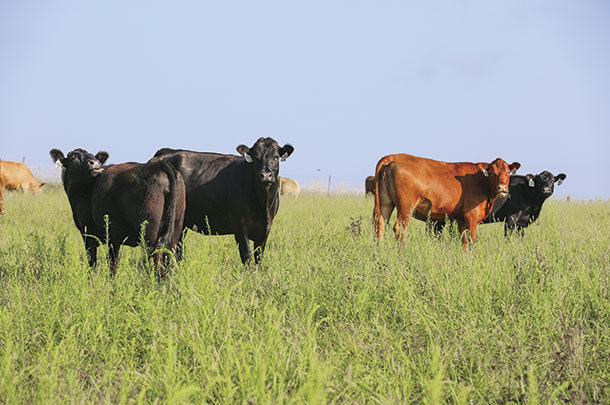Hot summer months present a real challenge for pasture management across the Midwest, specifically maintaining forage quality and keeping pastures healthy.
No matter the region, the most important consideration for producers is planning grazing cycles and rotations. To maximize productivity, pastures and paddocks require rest periods to recover, when the plants can convert the sun’s energy into sugars needed for regrowth.
Grazing height is always critical but even more so during summer. When livestock are allowed to graze below recommended levels (Table 1), stored carbohydrates in the forage plant are removed, and more time is needed for the plant to recover.

A short video produced by the University of Kentucky shows the importance of managing cutting heights. The video can be viewed online (La Crosse Seed).
Leaving sufficient leaf mass is critical for gathering sunlight and keeping root systems from becoming overly stressed. This approach, often called “take half, leave half,” also ensures the remaining forage shades the soil, which reduces weed competition and potential moisture loss.
However, it is important for producers to understand grazing cycles will slow down during the summer when compared to spring and fall. Due to this, the growth captured in only one or two weeks during cooler months may take two or three times longer in the middle of the year.
Here are additional fundamental summer management tips to maximize pasture productivity.
- Fertility – Timely applications of nitrogen (N), phosphorus (P), potassium (K) and secondary nutrients help increase total production and extend spring grass growth into early summer. For cool-season species, the greatest growth stage typically winds down in June, so extreme amounts of N are not needed during summer. However, sufficient N must be available prior to the start of spring and early summer, so it is recommended to apply N prior to that timeframe.
Some producers follow a “holiday program,” meaning they feed pastures around Memorial Day, July 4 and Labor Day. While three feedings are more efficient and productive than only one or even two applications, it is common for many growers to avoid applications on pastures altogether during hot and dry weather so as not to burn leaf tissue.
With warm-season grasses (sorghum-sudangrass, pearl millet, etc.), N should be applied prior to summer to maximize yield. (Our team uses 1.25 pounds actual N per growing day for warm-season annuals.) Summer applications of P and K on most pastures are not as critical, depending on soil test levels and soil type. If soil test levels are low, or the pasture is heavy in legumes, it may make sense to plan a late summer application of P and K to maintain production levels.
Most importantly, if soil tests have not been taken in the last three to four years, it’s a good idea to pull samples this summer. Managing pastures without knowledge of current fertility levels is like building a house without a set of plans.
- Weed control – While pasture weed control can be a challenge for many producers, eliminating weeds increases pasture quality and animal performance. Most annual weeds are relatively easy to manage with herbicides or mowing. Conversely, biennial and perennial weeds may need to be managed as much as controlled. The key to management of any weed is to prevent its establishment (especially in mixed pastures).
A well-managed pasture will outcompete most weed species and reduce weed infestations. Several herbicide options offer producers the chance to control many broadleaf weeds and winter annuals in grass pastures (like 2,4-D and dicamba-based products).
Likewise, herbicides to control grass weeds are widely available for legume stands. It is more challenging to eliminate grass weeds within grass or grass/legume stands. Mowing or clipping can take the place of chemical options when limited herbicide options exist and weather conditions allow for it.
Remember, weeds growing in low-moisture environments are more difficult to control. It may make more sense to mow in summer and then control with weeds with herbicides later in the season.
Last, be sure to read and understand the herbicide label, as most products carry grazing or haying restrictions, some of which may last more than a year. Note: Restrictions for beef cattle are often different than for lactating dairy animals. The label is the law.
-
Manure – If manure is to be applied, spread the lowest N content manure during the summer. Keep in mind, when manure is spread on pastures at the same time grazing livestock are present, pastures can often contain both internal and external parasites, potentially leading to sickness and other disorders.
Dragging can help control the spread of parasites, as sunlight aids in destroying parasitic eggs and larvae. Dragging also distributes nutrients more evenly across the pasture while allowing air and water penetration. This is especially recommended if a seeding is planned in later summer or early fall.
- Interseeding – In areas where pastures may be weakened from overgrazing or hoof traffic, plan now for a late-summer seeding. No-till drills or seeders are widely available and can be rented from most USDA service centers. Integrating legumes or smaller-seeded grasses before the fall can thicken stands more quickly than the more traditional frost seeding practices during the late winter and early spring. Obviously, pastures with severe slopes make seeding with drills more challenging and overseeding methods more conducive.
Another consideration is to incorporate summer annuals into the grazing system. Warm-season grasses can offset the “summer slump” as they thrive in warm and dry conditions, often producing two to five times more forage than conventional cool-season grasses during the summer months.
Ultimately, pastures not adequately managed will result in poor quality (especially protein deficiency) and weakened resiliency. Improving your pastures can improve overall herd health by increasing forage intake and digestibility, increasing conception rates and maximizing milk production. Cattle rely on having forage 12 months out of the year, so make plans now to minimize any production lags this summer. ![]()
PHOTO: Fertility, weed control, manure application and interseeding are ways to help maintain pasture health to provide forage throughout summer weather patterns. Photo by Julie Brown.

-
Scott Wohltman
- Certified Crop Adviser
- Forage First and La Crosse Seed
- Email Scott Wohltman









